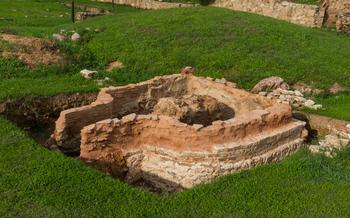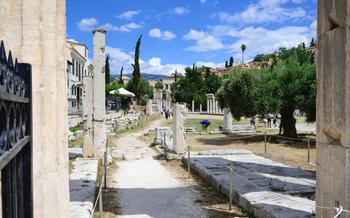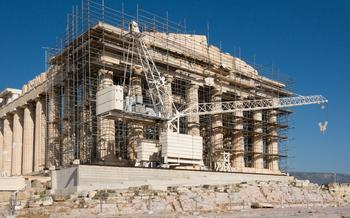
Philopappos Hill
- A Stroll Uphill
- A Monument to a Beloved Prince
- A Panoramic View of Athens
- A Sanctuary of Dionysus
- A World War II Bunker
- A Haven for Nature Lovers
- A Place of Serenity and Reflection
- A Cultural Landmark
- A Symbol of Continuity
- A Must-See for History Buffs
- Fortified Walls and Gates
- Ancient Tombs and Cemeteries
- The Hill of the Muses
- A Place for Picnics and Relaxation
- Insider Tip:
A Stroll Uphill
Philopappos Hill, a prominent landmark in Athens, offers an enriching historical experience, presenting a glimpse into the ancient world. Steeped in history, the hill was once home to a sanctuary dedicated to the Muses, the goddesses of the arts and sciences, and served as a burial ground for notable Athenians, including the Roman consul Gaius Julius Antiochus Philopappos, who was honored with a grand monument atop the hill.
To fully immerse yourself in the hill's rich past, begin your exploration from the Pnyx, the birthplace of Athenian democracy, where assemblies were held during ancient times. From here, follow the path that leads uphill, passing the prison of Socrates, where the great philosopher spent his final days, and the ancient quarries, where massive stone blocks were extracted for the construction of Athens' monumental buildings.
While ascending the hill, take in the stunning views of the city unfolding before you. Choose the early morning or late afternoon hours to avoid the midday heat and crowds, allowing you to fully appreciate the tranquility and serenity of the surroundings.
A Monument to a Beloved Prince
Philopappos, a prince from the Kingdom of Commagene in southeastern Anatolia, was a prominent figure in ancient Athens. Known for his generosity and contributions to the city, he held several important positions, including that of archon, the chief magistrate. After his death in 116 AD, the Athenians honored his memory by erecting a magnificent monument on the hill that now bears his name.
The Philopappos Monument is a unique and striking structure that stands as a testament to the prince's legacy. Drawing inspiration from Roman mausoleums, the monument features a square base with a circular drum supporting a conical roof. The exterior is adorned with exquisite reliefs depicting scenes from Philopappos' life, as well as allegorical representations of his virtues and accomplishments.
One of the most notable reliefs portrays Philopappos riding on horseback, leading a procession of his people. Other panels depict him distributing grain to the poor and engaging in various civic activities. The monument's iconography also includes symbols of the Roman Empire, such as eagles and fasces, reflecting Philopappos' close ties with Rome.
In the 19th century, the monument received a visit from a famous German archaeologist, Ernst Curtius. Intrigued by the reliefs, Curtius spent hours studying them, making detailed sketches and notes. His meticulous work helped to shed light on the life and achievements of Philopappos, bringing new insights into the history of ancient Athens.
A Panoramic View of Athens
The ascent to Philopappos Hill is rewarded with breathtaking panoramic views of Athens, stretching from the ancient ruins to the sprawling modern metropolis. From the hilltop vantage point, you can admire the iconic landmarks that define the city's skyline, including the majestic Acropolis, with its Parthenon temple perched atop, and the ancient Agora, where democracy was once born. Gaze upon Mount Lycabettus, the highest point in Athens, rising majestically in the distance.
The panorama from Philopappos Hill is a photographer's paradise, offering endless opportunities to capture stunning images of the city. Whether you're a professional photographer or simply an enthusiast with a smartphone, you'll find yourself captivated by the ever-changing light and shadows that play across the urban landscape. As the sun sets, the cityscape transforms into a sea of twinkling lights, creating a magical and unforgettable sight.
My personal favorite time to visit Philopappos Hill for the most impressive views is early in the morning, when the air is crisp and clear. The golden light of the rising sun casts a warm glow on the city, illuminating the ancient monuments and revealing the intricate details of their architecture. It's a truly magical experience to witness Athens awakening from its slumber, with the sounds of birdsong filling the air and the city gradually coming to life below.
A Sanctuary of Dionysus
Amidst the historical and cultural treasures of Philopappos Hill lies a lesser-known sanctuary dedicated to the Greek god of wine and theater, Dionysus. This sacred site holds significant importance within the context of ancient Athenian religious practices.
Dionysus, revered for his ability to bring joy and inspiration through wine and the arts, was widely worshipped in ancient Greece. The sanctuary on Philopappos Hill served as a place of devotion and celebration for his followers.
Although the sanctuary has undergone the ravages of time, remnants of its former glory remain. Visitors can explore the ruins of the theater, where dramatic performances once took place, and the temple, where offerings were made to the deity. Other structures, such as a stoa and a cistern, provide glimpses into the daily rituals and activities that took place within the sanctuary.
According to ancient mythology, Dionysus was closely associated with the area surrounding Philopappos Hill. It is said that he was born on Mount Hymettus, located to the southeast of the hill, and that he often roamed the slopes of Philopappos, inspiring the local shepherds with his music and revelry.
One of the most intriguing aspects of the sanctuary is the presence of a large rock-cut relief depicting Dionysus and his entourage. This impressive artwork, carved into the natural rock formations of the hill, showcases the god's procession, accompanied by satyrs, maenads, and other mythical figures. The relief offers a glimpse into the vibrant and colorful festivals that were held in honor of Dionysus.
Whether you are a history buff, a theater enthusiast, or simply someone interested in exploring the hidden gems of ancient Athens, the sanctuary of Dionysus on Philopappos Hill is a must-visit destination. Its rich history, archaeological significance, and connection to the legendary god of wine and theater make it a truly unique and captivating site.
A World War II Bunker
Amidst the ancient ruins and natural beauty of Philopappos Hill lies a hidden relic of a more recent historical era: a World War II bunker. Constructed during the tumultuous years of the war, this bunker served as a strategic observation post for the Greek resistance fighters. Concealed within the hill's rocky terrain, the bunker provided a vantage point for monitoring enemy movements and relaying vital information to Allied forces.
Today, the bunker stands as a silent testament to the resilience and determination of the Greek people during a time of great adversity. Although its exact purpose and history remain shrouded in secrecy, visitors can still explore this intriguing relic and imagine the tense atmosphere that once filled its dimly lit chambers. The bunker's presence on Philopappos Hill serves as a reminder of the many layers of history that this ancient site holds, blending the past with the present in a poignant and evocative manner.
A Haven for Nature Lovers
Philopappos Hill is not just a historical and cultural site; it is also a haven for nature lovers. The hill is home to a diverse array of flora and fauna, including wildflowers, olive trees, and various bird species. The wildflowers, which bloom in vibrant colors during the spring, create a picturesque tapestry that covers the hill's slopes. Olive trees, with their gnarled trunks and silvery leaves, add a touch of rustic charm to the landscape. The hill is also a haven for birds, with species such as goldfinches, hoopoes, and nightingales being commonly spotted. Birdwatching enthusiasts can spend hours observing these feathered creatures as they flit among the trees and bushes.
Beyond its natural beauty, Philopappos Hill also plays an important role in preserving the city's biodiversity. The hill's diverse habitats provide shelter and sustenance for a variety of wildlife, contributing to the ecological balance of the urban environment. It serves as a reminder of the importance of protecting natural spaces within urban areas, especially in a city like Athens, which is known for its bustling streets and dense population.
For those seeking a peaceful retreat from the hustle and bustle of city life, Philopappos Hill offers an oasis of tranquility. Visitors can stroll along the winding paths, surrounded by the sounds of birdsong and the rustling of leaves, and immerse themselves in the beauty of the natural surroundings. Whether you're a nature enthusiast, a birdwatcher, or simply someone seeking a moment of peace and tranquility, Philopappos Hill has something to offer.
A Place of Serenity and Reflection
Philopappos Hill exudes a serene and contemplative atmosphere that invites visitors to slow down, reflect, and connect with their inner selves. For centuries, people from all walks of life have sought solace and inspiration amidst the hill's tranquil surroundings. Ancient philosophers and poets found it a conducive place to contemplate life and the universe, while modern-day visitors come to escape the hustle and bustle of city life and find a moment of peace and tranquility.
The hilltop is dotted with benches and quiet spots where one can sit and simply soak in the surroundings, enjoying the panoramic views of the city, the scent of wildflowers, and the gentle breeze rustling through the olive trees. It's a place where you can let your mind wander, meditate, or simply be present in the moment.
Whether you're seeking solace from a busy life, inspiration for your creative pursuits, or simply a peaceful place to relax and reflect, Philopappos Hill offers a sanctuary for the soul. Take some time to sit in silence, breathe in the fresh air, and let the serenity of the hill wash over you. You may just find that you leave feeling refreshed, rejuvenated, and more connected to yourself and the world around you.
A Cultural Landmark
Philopappos Hill is not only a place of historical significance but also an active site of archaeological excavations and restoration work. Ongoing efforts aim to uncover the hill's rich past and preserve its cultural heritage for future generations. Archaeologists have discovered ancient artifacts, structures, and inscriptions that shed light on the hill's various uses and inhabitants throughout history. These findings provide valuable insights into the daily lives, beliefs, and customs of ancient Athenians.
One of the most exciting aspects of visiting Philopappos Hill is the opportunity to witness these excavations firsthand. Visitors can observe archaeologists at work, uncovering ancient treasures and piecing together the puzzle of the hill's past. Restoration efforts are also underway to preserve and protect the existing structures, ensuring that this unique cultural landmark remains accessible and enjoyable for generations to come.
A Symbol of Continuity
Philopappos Hill stands as a testament to the enduring legacy of Athens, a city that has witnessed countless transformations throughout its long and storied history. The hill's ability to bridge the gap between ancient and modern times is truly remarkable. While it remains deeply rooted in the past, with its ancient ruins, monuments, and artifacts, it also embraces the present, offering stunning views of the modern cityscape.
This harmonious coexistence of the old and the new is a defining characteristic of Philopappos Hill. It serves as a reminder that even as cities evolve and progress, their historical roots continue to shape their identity. The hill's enduring appeal lies in its ability to connect visitors with the rich tapestry of Athens's past while simultaneously offering a glimpse into its vibrant present.
In this sense, Philopappos Hill is not merely a historical site but also a symbol of continuity. It represents the resilience of Athens, a city that has repeatedly risen from adversity to maintain its status as a cultural and intellectual hub. The hill's ability to adapt to changing times and remain relevant to successive generations is a testament to the enduring spirit of the Athenian people.
Whether you're a history buff, a nature lover, or simply someone seeking a tranquil oasis amidst the urban bustle, Philopappos Hill has something to offer. Its enduring legacy as a place of historical, cultural, and natural significance ensures that it will continue to captivate visitors for generations to come.
A Must-See for History Buffs
Philopappos Hill is a treasure trove of historical wonders, offering a glimpse into Athens' rich and storied past. As you ascend the hill, you'll encounter ancient ruins, monuments, and artifacts that tell the tale of a city that has stood the test of time. Explore the remains of ancient fortifications, marvel at the grandeur of the Philopappos Monument, and discover hidden tombs and cemeteries that reveal the funerary practices of ancient Athenians. Each step you take on Philopappos Hill is a journey through history, a chance to connect with the spirits of the past and gain a deeper understanding of the forces that shaped this remarkable city.
Personal Experience:
During my visit to Philopappos Hill, I stumbled upon a particularly fascinating historical discovery. As I wandered through the ruins, I noticed a small, unassuming stone fragment lying on the ground. Curiosity piqued, I picked it up and examined it closely. To my astonishment, I realized that I was holding a piece of an ancient Athenian pottery vessel. The intricate designs and faded colors hinted at the artistry and craftsmanship of its maker. In that moment, I felt a profound connection to the past, as if I were holding a piece of history in my hands. The discovery reminded me of the countless stories that lie buried beneath the surface of Philopappos Hill, waiting to be unearthed and shared with the world.
Fortified Walls and Gates
Philopappos Hill was once a strategic military stronghold, protected by a formidable system of fortifications. Remains of these ancient defenses can still be seen today, offering a glimpse into the hill's role in defending the city of Athens. The most impressive surviving structure is the Gate of Athena Archegetis, a well-preserved gateway that allowed access to the hilltop.
Exploring the fortifications of Philopappos Hill is a journey through time, transporting visitors back to an era of fierce battles and sieges. The sturdy walls, strategically positioned towers, and well-thought-out gates reveal the ingenuity and military prowess of the ancient Athenians.
As you wander among the ruins, imagine the soldiers manning the walls, keeping watch for approaching enemies. Picture the clash of swords and the roar of battle echoing through the valleys. The fortifications of Philopappos Hill stand as silent witnesses to the city's turbulent past, adding a layer of intrigue and historical depth to this already captivating site.
Ancient Tombs and Cemeteries
The slopes of Philopappos Hill are dotted with numerous ancient tombs and cemeteries, providing a glimpse into the funerary practices and beliefs of ancient Athenians. These burial sites range from simple graves to elaborate rock-cut tombs, each telling a unique story about the lives and deaths of the city's inhabitants.
One of the most impressive tombs is the so-called "Tomb of the Nereids," which dates back to the 4th century BC. Carved into the hillside, the tomb features a Doric frieze depicting scenes from Greek mythology, including the wedding of Peleus and Thetis, the parents of the hero Achilles.
Another notable tomb is the "Tomb of the Archon," which belonged to a high-ranking Athenian official. The tomb is adorned with intricate reliefs depicting scenes from everyday life, such as a banquet and a funeral procession.
Exploring these ancient tombs and cemeteries is a fascinating way to learn about the lives and deaths of ordinary Athenians, as well as the religious beliefs and practices that shaped their society.
The Hill of the Muses
Philopappos Hill is closely associated with the Muses, the goddesses of the arts and sciences in Greek mythology. It is believed that a sanctuary dedicated to the Muses once stood on the hilltop, although its exact location has not been definitively identified. The hill's natural beauty and tranquility have long inspired artists and thinkers, who have sought refuge and inspiration amidst its verdant slopes. The Muses were believed to reside on Mount Helicon, but they were also associated with other hills and mountains, including Philopappos Hill. The presence of the Muses on Philopappos Hill is a testament to the hill's enduring significance as a place of creativity and intellectual pursuit.
Personal Experience:
During my visit to Philopappos Hill, I couldn't help but feel a sense of inspiration and creativity as I wandered among the ancient ruins and lush greenery. The hill's serene atmosphere and stunning views provided the perfect backdrop for contemplation and reflection. As I sat on a bench beneath an olive tree, I couldn't help but imagine the ancient Greek poets and philosophers who had once sought inspiration in this very spot. The Muses seemed to whisper in my ear, encouraging me to tap into my own creative potential. Whether you're a writer, an artist, a musician, or simply someone who appreciates the beauty of nature, Philopappos Hill is a place where you can find inspiration and let your creativity soar.
A Place for Picnics and Relaxation
Philopappos Hill is not just a historical and cultural treasure; it's also a popular spot for picnics and leisurely outings. Several designated picnic areas and benches are scattered throughout the hilltop, inviting visitors to bring a packed lunch and enjoy a meal with a view. Imagine spreading out a blanket beneath the shade of an ancient olive tree, savoring delicious food, and taking in the breathtaking panorama of Athens.
The hill's tranquil atmosphere and stunning vistas make it an ideal place to relax and unwind. Whether you're a local looking for a serene escape from the city hustle or a tourist seeking a unique picnic experience, Philopappos Hill has something to offer. So, pack a basket of your favorite treats, find a cozy spot, and let the beauty of Athens surround you as you savor a delightful picnic on this historic hilltop.
Insider Tip:
- For an unforgettable sunset experience, head to the Philopappos Hill viewpoint just before dusk. As the sun dips below the horizon, the sky erupts in a kaleidoscope of colors, painting the city in hues of gold, pink, and purple. Find a spot to sit and savor this magical moment as the lights of the city begin to twinkle below.
- To escape the crowds, venture off the main path and explore the lesser-known trails that crisscross the hill. These hidden gems offer tranquility and solitude, allowing you to fully immerse yourself in the beauty of the natural surroundings.
- Combine your visit to Philopappos Hill with a stroll through the nearby Anafiotika neighborhood. This charming quarter, nestled on the slopes of the hill, offers a glimpse into a bygone era with its whitewashed houses, narrow streets, and stunning views of the Acropolis.
- During my last visit, I stumbled upon a hidden cave tucked away among the rocks. Inside, I discovered an ancient inscription that transported me back in time. It was a truly unexpected and awe-inspiring experience that made my visit to Philopappos Hill all the more memorable.









